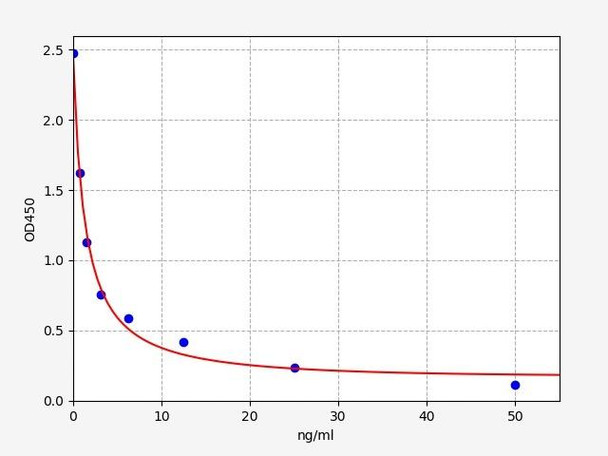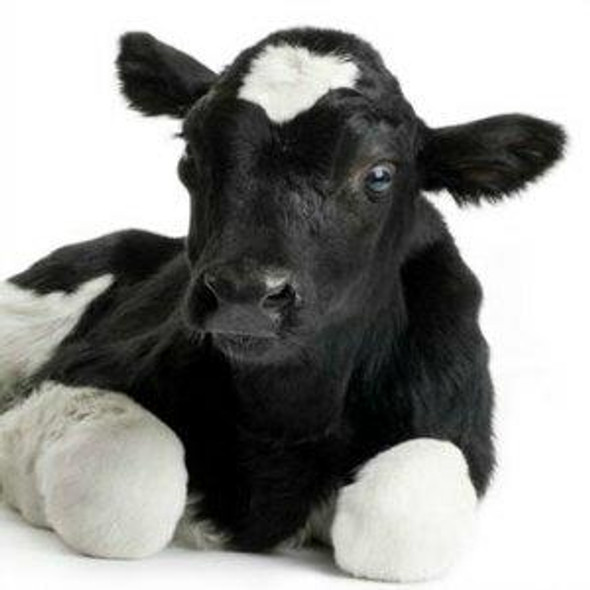Bovine PRL (Prolactin) ELISA Kit
- SKU:
- BOFI00007
- Product Type:
- ELISA Kit
- Size:
- 96 Assays
- Uniprot:
- P01239
- Sensitivity:
- 0.469ng/ml
- Range:
- 0.781-50ng/ml
- ELISA Type:
- Competitive
- Synonyms:
- Lactotrope, LTH, Luteotropic Hormone
- Reactivity:
- Bovine
Description
| Product Name: | Bovine PRL (Prolactin) ELISA Kit |
| Product Code: | BOFI00007 |
| Size: | 96 Assays |
| Target: | Bovine PRL |
| Alias: | Lactotrope, LTH, Luteotropic Hormone |
| Reactivity: | Bovine |
| Detection Method: | Competitive ELISA, Coated with Antibody |
| Sensitivity: | 0.469ng/ml |
| Range: | 0.781-50ng/ml |
| Storage: | 4°C for 6 months |
| Note: | For Research Use Only |
| Recovery: | Matrices listed below were spiked with certain level of Bovine PRL and the recovery rates were calculated by comparing the measured value to the expected amount of Bovine PRL in samples. | ||||||||||||||||
| |||||||||||||||||
| Linearity: | The linearity of the kit was assayed by testing samples spiked with appropriate concentration of Bovine PRL and their serial dilutions. The results were demonstrated by the percentage of calculated concentration to the expected. | ||||||||||||||||
| |||||||||||||||||
| Intra-Assay: | CV <8% | ||||||||||||||||
| Inter-Assay: | CV <10% |
| Uniprot: | P01239 |
| UniProt Protein Function: | prolactin: Prolactin acts primarily on the mammary gland by promoting lactation. Belongs to the somatotropin/prolactin family. |
| UniProt Protein Details: | Protein type:Cytokine; Motility/polarity/chemotaxis; Secreted; Secreted, signal peptide Cellular Component: cytosol; endoplasmic reticulum lumen; endoplasmic reticulum membrane; extracellular space Molecular Function:hormone activity; prolactin receptor binding Biological Process: activation of NF-kappaB transcription factor; biosynthetic process; blastocyst formation; lactation; long-day photoperiodism; negative regulation of apoptosis; peptide hormone secretion; positive regulation of endocytosis; positive regulation of fatty acid biosynthetic process; positive regulation of NF-kappaB import into nucleus; positive regulation of nitric oxide biosynthetic process; response to external biotic stimulus; response to food; response to mechanical stimulus |
| UniProt Code: | P01239 |
| NCBI GenInfo Identifier: | 46810277 |
| NCBI Gene ID: | 280901 |
| NCBI Accession: | NP_776378.2 |
| UniProt Secondary Accession: | P01239,Q29417, Q95112, A6QLX8, |
| UniProt Related Accession: | P01239 |
| Molecular Weight: | 25,793 Da |
| NCBI Full Name: | prolactin |
| NCBI Official Symbol: | PRL |
| NCBI Official Synonym Symbols: | GHA1; Prol |
| NCBI Protein Information: | prolactin |
| UniProt Protein Name: | Prolactin |
| Protein Family: | Prolactin |
| UniProt Gene Name: | PRL |
| UniProt Entry Name: | PRL_BOVIN |
| Step | Procedure |
| 1. | Set standard, test sample and control (zero) wells on the pre-coated plate respectively, and then, record their positions. It is recommended to measure each standard and sample in duplicate. Wash plate 2 times before adding standard, sample and control (zero) wells! |
| 2. | Add Sample and Biotin-detection antibody: Add 50µL of Standard, Blank or Sample per well. The blank well is added with Sample Dilution Buffer. Immediately add 50 µL of biotin-labelled antibody working solution to each well. Cover with the plate sealer provided. Gently tap the plate to ensure thorough mixing. Incubate for 45 minutes at 37°C. (Solutions are added to the bottom of micro-ELISA plate well, avoid touching plate walls and foaming). |
| 3. | Wash: Aspirate each well and wash, repeating the process three times. Wash by filling each well with Wash Buffer (approximately 350µL) using a squirt bottle, multi-channel pipette, manifold dispenser or automated washer. Complete removal of liquid at each step is essential to good performance. After the last wash, remove any remaining Wash Buffer by aspirating or decanting. Invert the plate and pat it against thick clean absorbent paper. |
| 4. | HRP-Streptavidin Conjugate(SABC): Add 100µL of SABC working solution to each well. Cover with a new Plate sealer. Incubate for 30 minutes at 37°C. |
| 5. | Wash: Repeat the aspiration/wash process for five times. |
| 6. | TMB Substrate: Add 90µL of TMB Substrate to each well. Cover with a new plate sealer. Incubate for about 10-20 minutes at 37°C. Protect from light. The reaction time can be shortened or extended according to the actual color change, but not more than 30 minutes. When apparent gradient appeared in standard wells, you can terminate the reaction. |
| 7. | Stop: Add 50µL of Stop Solution to each well. Color turn to yellow immediately. The adding order of stop solution should be as the same as the substrate solution. |
| 8. | OD Measurement: Determine the optical density (OD Value) of each well at once, using a microplate reader set to 450 nm. You should open the microplate reader ahead, preheat the instrument, and set the testing parameters. |
When carrying out an ELISA assay it is important to prepare your samples in order to achieve the best possible results. Below we have a list of procedures for the preparation of samples for different sample types.
| Sample Type | Protocol |
| Serum: | If using serum separator tubes, allow samples to clot for 30 minutes at room temperature. Centrifuge for 10 minutes at 1,000x g. Collect the serum fraction and assay promptly or aliquot and store the samples at -80°C. Avoid multiple freeze-thaw cycles. If serum separator tubes are not being used, allow samples to clotovernight at 2-8°C. Centrifuge for 10 minutes at 1,000x g. Removeserum and assay promptly or aliquot and store the samples at-80°C. Avoid multiple freeze-thaw cycles. |
| Plasma: | Collect plasma using EDTA or heparin as an anti-coagulant. Centrifuge samples at 4°C for 15 mins at 1000 - g within 30 mins of collection. Collect the plasma fraction and assay promptly or aliquot and store the samples at -80°C. Avoid multiple freeze-thaw cycles.Note: Over haemolysed samples are not suitable for use with this kit. |
| Urine & Cerebrospinal Fluid: | Collect the urine (mid-stream) in a sterile container, centrifuge for 20 mins at 2000-3000 rpm. Remove supernatant and assay immediately. If any precipitation is detected, repeat the centrifugation step. A similar protocol can be used for cerebrospinal fluid. |
| Cell Culture Supernatant: | Collect the cell culture media by pipette, followed by centrifugation at 4°C for 20 mins at 1500 rpm. Collect the clear supernatant and assay immediately. |
| Cell Lysates: | Solubilize cells in lysis buffer and allow to sit on ice for 30 minutes. Centrifuge tubes at 14,000 x g for 5 minutes to remove insoluble material. Aliquot the supernatant into a new tube and discard the remaining whole cell extract. Quantify total protein concentration using a total protein assay. Assay immediately or aliquot and store at ≤ -20°C. |
| Tissue Homogenates: | The preparation of tissue homogenates will vary depending upon tissue type. Rinse tissue with 1X PBS to remove excess blood & homogenizein 20ml of 1X PBS (including protease inhibitors) and store overnight at ≤ -20°C. Two freeze-thaw cycles are required to break the cell membranes. To further disrupt the cell membranes you can sonicate the samples. Centrifuge homogenates for 5 mins at 5000xg. Remove the supernatant and assay immediately or aliquot and store at -20°C or-80°C. |
| Tissue Lysates: | Rinse tissue with PBS, cut into 1-2 mm pieces, and homogenize with a tissue homogenizer in PBS. Add an equal volume of RIPA buffer containing protease inhibitors and lyse tissues at room temperature for 30 minutes with gentle agitation. Centrifuge to remove debris. Quantify total protein concentration using a total protein assay. Assay immediately or aliquot and store at ≤ -20 °C. |
| Breast Milk: | Collect milk samples and centrifuge at 10,000 x g for 60 min at 4°C. Aliquot the supernatant and assay. For long term use, store samples at -80°C. Minimize freeze/thaw cycles. |
| Nevard et al. | Investigating the impact of plasma prolactin on maternal behaviour, calf health and bull fertility in beef cattle | 2023 | View Citation |
| Nevard et al. | Periparturient plasma prolactin concentrations and maternal behavior in beef cattle | Society for Theriogenology Conference 2023 | View Citation |
| Nevard et al. | Influence of season and plasma prolactin concentrations on fertility of Bos taurus beef bulls. | Society for Theriogenology Conference 2023 | View Citation |






